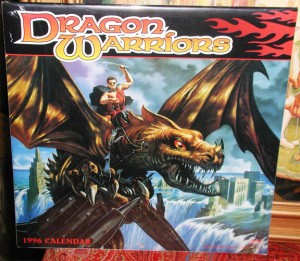
Elsewhere I have written, and optimistically, about one of the newer trends in collecting SF/F genre art, and one that is emerging as a fine way to satisfy collectors and artists who prefer artworks created in traditional media. And that is the growing acceptance (collectibility) of personal works created by artists, and the rising numbers of collectors who are privately commissioning artists to paint paintings under their direction. Can these artworks compete with, will they be taken as seriously in the collectibles marketplace as, commercially commissioned illustrations?
I have also written, and pessimistically, about the opportunities today for artists who want to keep painting, and collectors who would like to continue to buy illustrative art, with BOTH groups preferring the art to gain the recognition, exposure, and status (if you like) that comes from print publication—as well as the (monetary) benefits accruing to both collectors and artists from images that can be associated “in print” with a popular (or historically important) author, character, title, series, publication, etc. For magazine, and then book publication is where, historically, this field of collecting has its roots, and what drove our interest in these images in the first place. Published illustration also carries a badge of distinction that is hard won, through years of verbal warfare with establishment art critics and fine-art collectors. Publication is therefore where, historically, the market value is.

Interestingly, the very same thing is true for, and can be said about, books.
For every ‘self-made’ author who has successfully negotiated POD (“print on demand”) and self-publication ventures, there are those in the opposing camp, who argue for the benefits, enjoyed by both readers and writers and collectors, of publication IN PRINT and through a recognized, established, book publisher. Those benefits are what stirred Andrew Porter, former publisher of SF Chronicle, to answer those advocating self-publication—in response to Amazon’s recent “heavy handed tactics” in gaining concessions from major publishers, and their negative effect on the publishing industry, with the following observation: “When you buy a novel, you know that the publisher has paid the author several thousand dollars, has edited, proofread, copy-edited, marketed, advertised and done numerous other processes to it before it reaches the marketplace. The novel is backed by the name and reputation the author and publisher have created over many years of publishing.”
Amazon’s veritable monopoly over the distribution of books published by established publishers, like Hachette, (and see Steve Davidson’s post for May 25, 2014 on this topic) poses a major obstacle to readers and collectors who want access to books—but what about admirers and collectors of book cover illustrations or, just as importantly, the artists who create them? Well, and to paraphrase Porter, we could say the very same assumptions have influenced collectors of science fiction and fantasy illustration art. As in: “When you buy a commissioned painting, you know that the publisher has paid the artist several thousand dollars, has art-directed, edited, marketed, advertised and done numerous other processes to the artwork before it reaches the marketplace. The Art is backed by the name and reputation that the publisher has created over many years of publishing.”

Oddly, strangely, and even, perhaps, uncomfortably (for those who prefer to remain pessimists) could there, might there, possibly be a way to achieve the same validation, the same positive outcomes in today’s digital, and monopolized, environment? That is to say, in a world where publishers are less and less inclined to commission works created in traditional media, and authors are less and less able to find established publishers whose books will be distributed by (let’s say) Amazon . . . at the profit margins these companies need, to survive . . .is there a way to overcome these obstacles?
The answer is a qualified “Yes.” And perhaps surprisingly (to those new to the field), this route to print publication has existed as a route to publication for decades.
The Tail Wags the Dog
Typically, publishers have been the ones – often acting through their art directors, who have commissioned the works in traditional media that art collectors today are finding increasingly desirable. Typically, commercial artists would present their bono fides through portfolios of works they created to show off their talents, and Art Directors would decide if artist’s style of expression and artistic skills were a good match to the project at hand (whether a magazine interior or toy packaging) and if the terms of payment and delivery were acceptable, “hired the wrist,” as they say, to do the job. A licensing agent may, or may not, be involved in this process. Typically, the artwork, in due course, would be used as called for in the contract. Typically . . . but not always. There have been other avenues to publication. Among them:
Following in the footsteps of Virgil Finlay, an artist who was known for inspiring publishers to hire authors to write stories based on art he had already created (as opposed to the reverse! ), Paul Lehr’s painting The Abandoned City inspired Algis Budrys to write the story story “Jeever’s Lost World” which appeared in his SF magazine “Tomorrow”—and naturally featured Paul’s painting on the cover.

Lehr is a good example of a commercial artist who just keeps painting, whether he has been paid to do so or not. Richard Powers did the same, as did John Berkey. Sooner or later, they figured, someone would come along who needed an image in a hurry – and so they kept a good supply on hand of paintings that “would work” for whatever SF project might come along.
Some artists paint “in hopes” of eventual use, especially artists who have a good idea of WHAT might appeal to art directors. The Clyde Caldwell “Lady on a Dragon,” which we purchased from the artist directly in the 1970s when he was trying to get a foothold in the field, is an example of such a “portfolio” piece that eventually was licensed by Heavy Metal magazine. And many successful illustrators can point to similar experiences. For collectors, buying “before” usage, vs. “after”—can translate into a major jump in market value if the artist grows in stature in the field because of his work for that publication/genre.
And then there are “accidental” publications, works produced by artists who had no expectation, intention or motive to have their art used in commercial ways, but yet end up seeing their work “in print” anyway. Two examples, resulting from two wildly different situations, would be Rosana Azar’s fine art oil painting which serendipitously ended up as a CD cover, 1993, and Gary Ruddell’s private commission from a collector, P.W., which ended up in a 1996 calendar devoted to images of DRAGONS. Who knew?
Against all odds, Rosana’s work was seen on display at the 50th Worldcon in Orlando, in 1992, by the owner of Arion Records. Who then contacted me and asked if her work was available for licensing. Rosana was not then, nor has she ever been, a commercial artist. She viewed herself as a “fine artist.” who just happened to meet me, and saw SF convention art shows as a way to gain exposure for her original art. She went along with the idea to have her artwork appear on a CD cover, amused that anyone would be interested in using her art that way. Despite winning art show awards, two appearances in Spectrum anthologies (1993, 1994), and even a nomination for a Chesley, 1992, Rosana had absolutely no desire to have her art used commercially and adamantly refused to accept any commissions for work. She soon dropped out of SF/F to continue her fine art career, pursuing representation from galleries, and teaching art.
Gary Ruddell was also amused – but in his case, by the idea of taking on a private commission from a fellow who had seen another one of his paintings and said “I want one like that one, but with me riding on the back.” Gary, an artist eminently capable of rendering the fellow’s likeness, rarely took on such uniquely personal jobs, and when he did, did so with the expectation that the paintings would never be usable (licensable) for commercial purposes. He was therefore astounded when I was able to include this piece in a group of images I “packaged” for one of my calendar projects for Landmark Calendars.
In sum, there can be some novel and totally unpredictable ways that personal, non-commissioned works can end up being published, used commercially, and also ways privately commissioned work can end up being published, and used commercially. If the artist involved has no interest in a commercial career, the commercial use is irrelevant. If the artist involved, on the other hand, aspires to such a career, and in fact develops one . . . AND if there are collectors out there to whom this kind of validation matters (which is the reason my “yes” is qualified, see above) then publication through these alternative avenues will be increasingly important as traditional routes shut down, or continue, but beyond reach . . . for artists who want to keep working in traditional media.
Collectors, take note! Your support of artists, whether by buying unpublished paintings, or through private commissions, may end up being critical to the survival of this genre (as a field unlike any other).











1 Comment